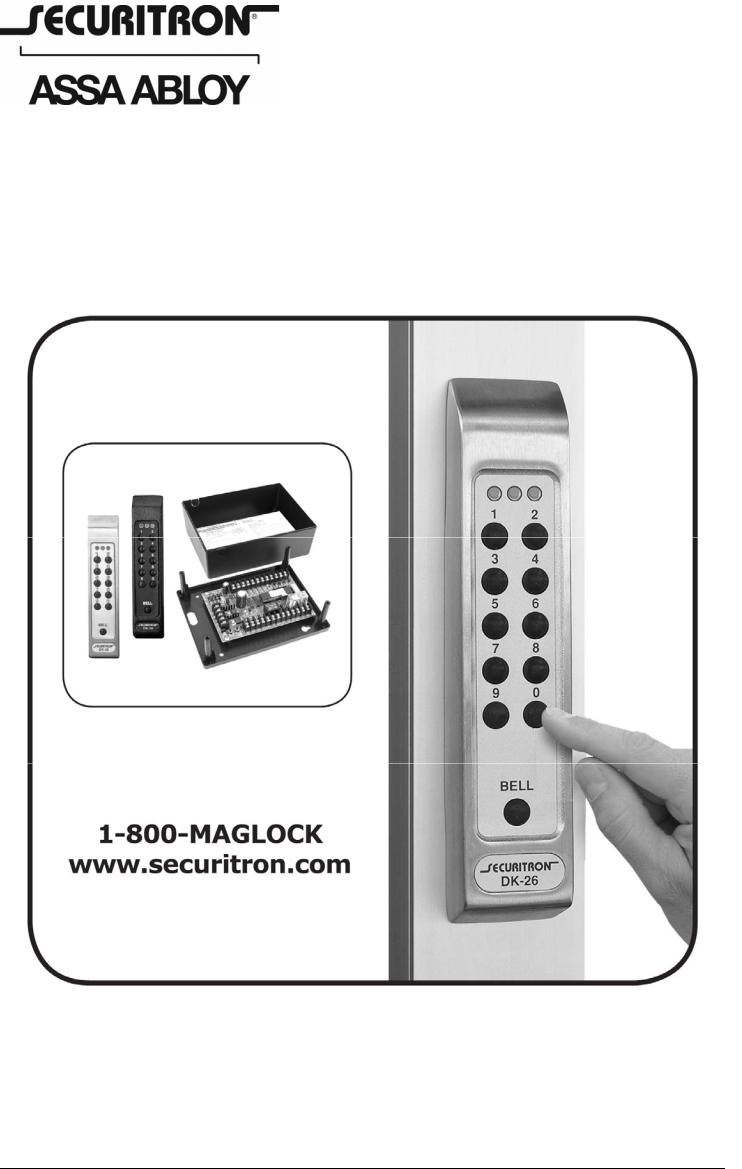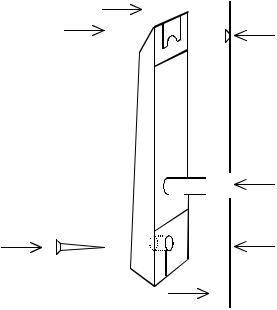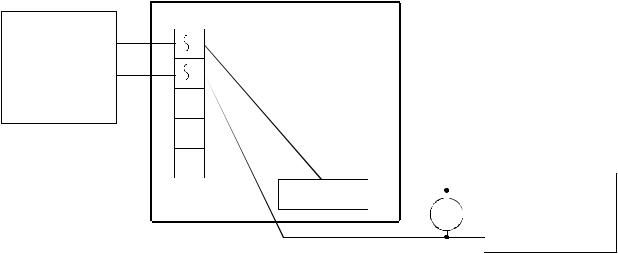Securitron DK-26BK, DK-26PBK, DK-26PSS, DK-26SS Installation Instructions

ASSA ABLOY, the global leader in door opening solutions
MODEL DK-26 DIGITAL KEYPAD SYSTEM INSTALLATION AND OPERATING INSTRUCTIONS
Securitron Magnalock Corp. |
www.securitron.com |
Tel 800.624.5625 |
techsupport@securitron.com |
© Copyright, 2011, all rights reserved |
PN# 500-16900 |
|
Rev. D, 12/11 |

Securitron Magnalock Corp. |
www.securitron.com |
ASSA ABLOY, the global leader |
Tel 800.624.5625 |
techsupport@securitron.com |
in door opening solutions |
SECURITRON MODEL DK-26 DIGITAL KEYPAD
TABLE OF CONTENTS AND GUIDE TO THIS MANUAL
SECTION 1. |
DESCRIPTION ------------------------------------------------------------- |
Page 2 |
|
SECTION 2. |
PHYSICAL INSTALLATION ---------------------------------------------- |
Page 2 |
|
SECTION 3. |
WIRING -------------------------------------------------------------------- |
Page 2 |
|
SECTION 3.1 |
POWER SELECTION ----------------------------------------------------- |
Page 2 |
|
SECTION 3.2 |
CONNECTING THE KEYPAD CABLE TO THE CPU BOARD ---------- |
Page 3 |
|
SECTION 3.3 |
POWER AND ELECTRIC LOCK WIRING------------------------------- |
Page 3 |
|
SECTION 3.3.1 |
AC LOCK WITH AC POWER ------------------------------------------ |
Page 3 |
|
SECTION 3.3.2 |
DC LOCK WITH AC POWER ------------------------------------------ |
Page 4 |
|
SECTION 3.3.3 |
DC LOCK WITH DC POWER ------------------------------------------ |
Page 5 |
|
SECTION 3.4 |
USE OF THE “F” TERMINAL -------------------------------------------- |
Page 6 |
|
SECTION 3.5 |
ADDING OTHER LOCK CONTROL SWITCHES------------------------ |
Page 6 |
|
SECTION 3.6 |
THE REX FUNCTION----------------------------------------------------- |
Page 6 |
|
SECTION 4. |
PROGRAMMING ----------------------------------------------------------- |
Page 8 |
|
SECTION 4.1 |
FIXED PROGRAMMING ------------------------------------------------- |
Page 8 |
|
SECTION 4.2 |
KEYPAD CHANGEABLE PROGRAMMING------------------------------ |
Page 9 |
|
SECTION 4.2.1 |
CHANGING THE USER AND PROG. CODE FROM KEYPAD ------- |
Page 10 |
|
SECTION 4.2.2. ADDING MULTIPLE USER CODES ---------------------------------- |
Page 10 |
||
SECTION 4.3 |
“MASTERKEY” USE OF THE HARD CODE ----------------------------- |
Page 11 |
|
SECTION 4.4 |
SUBSET CODES ---------------------------------------------------------- |
Page 11 |
|
SECTION 4.5 |
DELETING CODES ------------------------------------------------------- |
Page 11 |
|
SECTION 4.6 |
SETTING THE TIME RANGE AND TOGGLE MODE ------------------- |
Page 12 |
|
SECTION 5. |
CHANGING LED AND BEEPER OPERATION --------------------------- |
Page 12 |
|
SECTION 6 USE OF THE PROGRAMMABLE RELAY ---------------------------------- |
Page 13 |
||
SECTION 6.1 |
DOORBELL FUNCTION -------------------------------------------------- |
Page 13 |
|
SECTION 6.2 |
DURESS FUNCTION ----------------------------------------------------- |
Page 13 |
|
SECTION 6.3 |
ANTI-TAMPER ALARM FUNCTION ------------------------------------ |
Page 13 |
|
SECTION 6.4 |
DOOR PROP ALARM FUNCTION --------------------------------------- |
Page 14 |
|
SECTION 6.5 |
NIGHTLIGHT FUNCTION ----------------------------------------------- |
Page 14 |
|
SECTION 7 ADDITIONAL HARD WIRED OPTIONS---------------------------------- |
Page 14 |
||
SECTION 7.1 |
DUAL PAD OPERATION ------------------------------------------------- |
Page 14 |
|
SECTION 7.2. HARD WIRED CODE DISABLING ------------------------------------- |
Page 15 |
||
SECTION 7.3 |
ALARM SYSTEM SHUNTING-------------------------------------------- |
Page 15 |
|
SECTION 7.4 |
ANTI-TAILGATING ------------------------------------------------------ |
Page 16 |
|
SECTION 7.5 |
WIRING WITH TOUCH SENSE BAR AND MAGNALOCK ------------ |
Page 16 |
|
APPENDIX A |
COMMAND SUMMARY---------------------------------------------------- |
Page 17 |
|
APPENDIX B |
TROUBLE SHOOTING ---------------------------------------------------- |
Page 17 |
|
|
MAGNACARE WARRANTY ----------------------------------------------- |
Page 21 |
|
© Copyright, 2011, all rights reserved |
PN# 500-16900 |
Page 1 |
Rev. D, 12/11 |

SECURITRON MODEL DK-26 DIGITAL KEYPAD
INSTALLATION & OPERATING INSTRUCTIONS
1. DESCRIPTION
Securitron's DK-26 is a digital keypad system designed for medium/high security control of electric locks. It consists of two components: the keypad and the CPU board connected by a 16 ft. cable. This allows the CPU board to be mounted within the protected area for higher security. Tampering with or even destroying the keypad will not release the door. The rugged stainless steel keypad may be mounted outdoors in any environment as it is fully weatherproof. The keypad features true 10 digit operation (keys are not paired), three LED’s and a beeper.
2. PHYSICAL INSTALLATION
The keypad is normally surface mounted on the outside of the door to be controlled, and the CPU Board is mounted inside the protected area safe from tampering.
To install the keypad, holes must be drilled for the 2 mounting screws and the cable. A template is not provided due to unavoidable variations on the cable exit of each keypad. Referring to Figure 1, note that the top screw engages the slot at the top of the keypad. Once the top screw has been installed, the location of the cable hole should be set roughly by positioning the keypad and marking the cable hole point. Make sure the keypad is pulled down firmly on to the screw. A 3/8" (10MM) hole is then drilled for the cable. After the cable has been pulled through, the final screw secures the keypad to the wall. Note finally that a blank rectangular label has also been furnished. This can be used to cover up the “BELL” legend if you don’t intend to utilize the doorbell function.
FIG. 1: PHYSICAL INSTALLATION OF KEYPAD
MOUNTING
SURFACE
CABLE 
(1) MOUNT SCREW TO ENGAGE SLOT AT TOP OF KEYPAD
DRILL 1/8" (3MM) HOLE
(2)DRILL 3/8" (10MM) HOLE FOR CABLE
(3)SECURE BOTTOM WITH SECOND SCREW. COVER SCREW HEAD WITH "DK-26" LABEL.
DRILL 1/8" (3MM) HOLE
NOTE: CHOOSE PHILIPS OR SPANNER (TAMPER) HEAD SCREW
The CPU Board must be installed in a dry location free of extremes of temperature and humidity. If the 16 ft., twelve conductor cable that is included is not of sufficient length, additional cabling can be spliced by the installer. However, a long cable run can give rise to electronic noise problems in certain environments. It should therefore be avoided where possible and in no case should cable length exceed 100 ft. (30 meters).
3. WIRING
3.1 POWER SELECTION
The DK-26 operates on 12 to 24 volts AC or DC. Nearly all electric locks operate on voltage within this range, so the power supply you would normally utilize to operate the electric lock will also operate the DK-26. Power consumption of the DK-26 depends on voltage and is shown on the following chart:
DK-26 POWER CONSUMPTION: |
12 VOLTS |
24 VOLTS |
RELAYS, LED’S, + BEEPER ON (MAX) |
160 mA |
190 mA |
|
PN# 500-16900 |
Page 2 |
Rev. D, 12/11 |

Be sure that your power source is of adequate capacity to operate both the lock and DK-26. If the installation is "under-powered", the voltage of the supply will drop rapidly when the lock is energized and this can crash the microprocessor.
3.2 CONNECTING THE KEYPAD CABLE TO THE CPU BOARD
There are 12 color coded wires in the keypad cable. Refer to Figure 3 and connect each wire to the indicated terminal on the CPU Board. No other connections may be made to these terminals (except if two keypads are used with one CPU board).
3.3 POWER AND ELECTRIC LOCK WIRING
The wiring scheme for electric lock control varies depending on the type of lock and the desired control. The following sections provide drawings and explanations for different types. Note that the DK-26 includes additional options which are covered in Sections 6 and 7.
Note installation of the MOV across the power wires to the lock. The MOV is the black disk shaped component furnished loose with the DK-26. Its function is to absorb inductive kickback from the lock’s coil. Without the MOV, this kickback voltage will arc over the relay contacts and reduce the switching life of the relay. The arc also creates electronic noise which could cause the microprocessor to malfunction. The MOV should be spliced into the lock power wires as close to the lock as possible. Some DC electric locks have internal kickback protection including all Securitron Magnalocks. You don’t need the MOV for these locks but if you are not sure, it does no harm to install the MOV so long as the lock power is in the 12-24 volt range.
3.3.1 AC LOCK WITH AC POWER
A fail secure lock operating on AC is used. This is generally an electric strike. “Fail secure” means that the lock is secure when it is not powered. Power is applied to release the lock. Referring to figure 2, select a transformer of the same output voltage as the lock (12 or 24 VAC). Make sure the capacity of the transformer is large enough to operate both the DK-26 and the lock and that the transformer is UL listed under the UL 294 standard. The two transformer secondary wires connect to the “AC input” terminals as shown (there is no polarity with AC). Power from one terminal then goes to the common of relay #1. The NO contact of relay #1 will power the lock (releasing the door) when a correct code is entered. Note that AC locks are normally all fail secure. If you come across a fail safe AC lock (secure when powered) you would merely make the connection to the lock from the NC1 rather than NO1 terminal.
FIG. 2: AC LOCK - AC POWER WIRING
TRANSFORMER
12 OR 24 VAC
|
|
AC |
|
|
IN |
|
|
F |
|
|
IN DC |
|
|
|
|
|
|
+ |
/OUT |
|
|
||
NC1 C1 NO1 |
|
|
AC FAIL SECURE |
|
|
||
|
|
||
|
MOV |
LOCK |
|
|
PN# 500-16900 |
Page 3 |
Rev. D, 12/11 |

FIG. 3: OVERVIEW OF CPU BOARD
|
|
|
|
|
|
|
|
|
|
|
|
KEYPAD CABLE |
|
|
|
|
|
|
|
|
|
|
|
|
|
|
|
|
||||||
|
|
|
|
|
|
|
|
|
|
|
|
VIOLET |
|
PINK |
|
ORANGE |
|
BEIGE |
|
BROWN |
|
GRAY |
|
BLACK |
|
WHITE |
|
BLUE |
|
RED |
|
YELLOW |
|
GREEN |
|
|
|
|
|
|
|
|
|
|
|
|
|
|
|
|
|
|
|
|
|
|
|
||||||||||||
|
|
|
|
|
|
|
|
|
|
|
|
KEYS |
|
KEYS |
|
KEYS |
|
KEYS |
|
KEYS |
|
KEYS |
|
KEYS |
|
COMMON |
|
BEEPER |
|
LED RED |
|
LED YEL |
|
LED GRN |
|
|
|
|
|
|
|
|
|
|
|
VIO |
PNK |
BGEORG |
BRN |
GRY |
BLK |
WHT |
BLU |
RED |
YEL |
GRN |
|||||||||||||
|
|
|
|
|
|
|
|
|
|
|
|
|
|
|
|
|
|
|
|
|
|
|
|
|
|
|
|
|
|
|
|
|
|
|
|
|
|
|
|
|
|
|
|
|
|
|
|
|
|
|
|
|
|
|
|
|
|
|
|
|
|
|
|
|
|
|
|
|
|
|
|
|
|
|
|
|
|
|
|
|
|
|
|
|
|
|
|
|
|
|
|
|
|
|
|
|
|
|
|
|
|
|
|
|
|
|
|
|
|
|
|
|
|
|
|
|
|
|
|
|
|
|
|
|
|
|
|
|
|
|
|
|
|
|
|
|
|
|
|
|
|
|
|
|
|
|
|
|
|
|
|
|
|
|
|
|
|
|
|
|
|
|
|
|
|
|
|
|
|
|
|
|
|
|
AC |
PS3 PS2 PS1 |
12/24 AC POWER |
|
IN |
|
FREE TERMINAL
12/24 DC NEGATIVE 12/24 DC POWER +
DC TERMINALS MAY ALSO BE USED AS OUTPUT TO POWER DC LOCK, IF AC POWER IS SUPPLIED
|
|
F |
|
|
|
|
|
|
|
|
|
|
||
|
|
DC |
|
|
|
|
|
|
|
|
|
|
||
|
|
|
|
|
|
|
|
|
|
|
||||
+IN/OUT |
|
|
|
|
|
|
|
|
|
|
||||
|
|
|
|
|
|
|
|
|
|
|
|
|
||
|
|
|
|
|
|
|
|
|
|
|
|
|
|
|
|
|
PRGM |
HARD |
|
SRC |
REX |
UCD |
|||||||
|
|
CODE |
CODE |
|
||||||||||
|
|
|
MODE PROGRAM SET TO PUSH |
|
CODE HARD PROGRAM TO PUSH |
|
|
|
|
|
|
|
||
|
|
|
|
|
|
|
|
|
|
|
||||
|
|
|
|
|
TERMS HCD UCD, REX, FOR .COM |
RELEASE) (REMOTE INPUT REX |
CODES USER ALL DISABLE |
|||||||
MICROPROCESSOR
AUX.
SOCKET
SPDT |
DPDT RELAY |
RELAY |
HCD  NCX CX NOX
NCX CX NOX NC2 C2 NO2
NC2 C2 NO2  NC1 C1 NO1
NC1 C1 NO1 
DISABLE |
|
|
RELAY CONTACTS |
RELAY |
|||
|
PROGRAM |
LOCK CONTROL |
|
HARD |
CONTACTS |
|
|
|
|
|
|
CODE |
|
|
RELAY CONTACTS |
|
|
|
|
|
|
|
RATED AT 5 AMPS |
3.3.2 DC LOCK WITH AC POWER
For convenience and economy, most DC electric locks can be operated from an AC transformer when the DK-26 is used. Select a transformer of the same voltage as the lock (12 or 24). The CPU board converts the input AC to DC to operate the lock. Make sure the capacity of the transformer is large enough to operate both the DK-26 and the lock and that the transformer is UL listed under the UL 294 standard. The lock must accept full wave rectified DC power. This is true of most DC locks (including Securitron’s Magnalocks) but some specialty units require regulated DC power. You must operate those as described in the next Section. Note finally that many DC lock installations call for battery backup. To achieve this, you must employ a DC battery backup power supply and also follow the wiring description in Section 3.3.3.
DC locks come in “fail secure” and “fail safe” versions. A fail secure lock is secure when not powered and a fail safe lock is secure when powered. All magnetic locks are fail safe. Figure 4 shows AC power being input to the AC terminals. The DC terminals furnish output power for
|
PN# 500-16900 |
Page 4 |
Rev. D, 12/11 |

the lock. DC locks operated in this way must not draw more than 2 Amps. The positive DC terminal connects to the common of relay #1 and either the NO1 terminal (if the lock is fail secure) or the NC1 terminal (if the lock is fail safe) connects to the lock’s positive power input. This is shown in dotted lines. You only connect one of these terminals. Note that some DC locks are polarized and you must connect lock power correctly to positive and negative. Others are not polarized and can be connected either way. Consult the lock instructions.
TRANSFORMER
12 OR 24 VAC
FIG. 4: DC LOCK - AC POWER WIRING
|
|
AC |
|
|
|
IN |
|
|
|
F |
|
|
|
INDC |
NOTE: MOV NOT REQUIRED IF |
|
|
||
|
|
||
+ |
/OUT |
SECURITRON MAGNALOCK IS USED |
|
|
|||
|
|
||
NC1 C1 NO1 |
IF FAIL SECURE |
DC FAIL SECURE |
+ |
||
|
MOV |
OR FAIL SAFE LOCK |
IF FAIL SAFE |
|
|
|
|
3.3.3 DC LOCK WITH DC POWER
Select a power supply of the same voltage as the lock (12 or 24). Make sure the capacity of the supply is large enough to operate both the DK-26 and the lock. The DK-26 does not require regulated power but certain specialized electric locks do, so follow the rule of matching the power supply to the requirements of the lock.
DC locks come in “fail secure” and “fail safe” versions. A fail secure lock is secure when not powered and a fail safe lock is secure when powered. All magnetic locks are fail safe. Figure 5 shows correct wiring. The positive DC terminal connects to the common of relay #1 and either the NO1 terminal (if the lock is fail secure) or the NC1 terminal (if the lock is fail safe) connects to the lock’s positive power input. This is shown in dotted lines. You only connect one of these two terminals. Note that some DC locks are polarized and you must be sure to connect the lock power wires correctly to positive and negative. Others are not polarized and it doesn’t matter which way they are connected. Consult the lock instructions.
FIG 5: DC LOCK - DC POWER WIRING
POWER SUPPLY
+
12 OR 24 VDC
DC POWER NEED NOT BE REGULATED
|
|
AC |
|
|
IN |
|
|
F |
|
|
IN DC |
|
|
|
|
|
|
+ |
/OUT |
|
|
||
|
NOTE: MOV NOT REQUIRED IF |
|
|
SECURITRON MAGNALOCK IS USED |
|
NC1 C1 NO1 |
IF FAIL SECURE |
DC FAIL SECURE |
+ |
||
|
MOV |
OR FAIL SAFE LOCK |
IF FAIL SAFE |
|
|
|
|
|
|
PN# 500-16900 |
Page 5 |
Rev. D, 12/11 |

3.4 USE OF THE “F” TERMINAL |
|
|
|
|
|
|
|
|
|
||||||
The F terminal on the power strip is not connected to |
|
|
AC |
FIRE ALARM |
|||||||||||
anything. |
It |
is |
a free |
terminal |
with |
either |
of |
two |
TRANS- |
|
CONTACTS |
||||
intended |
uses. |
First, |
on |
some |
complicated |
|
|
N |
|
||||||
|
|
|
|
|
|
|
|
|
|
|
|
|
|
|
|
installations, |
a large number |
of |
wires |
(generally |
DC |
FORMER |
|
IN |
C |
C |
|||||
|
|
||||||||||||||
negative) |
may |
require |
termination. |
It |
can |
be |
|
|
|
|
|||||
|
|
F |
|
|
|||||||||||
convenient to run a jumper from the DCterminal to |
|
|
|
|
|||||||||||
|
|
|
WHEN THE FIRE |
||||||||||||
the F terminal so that the large number of negative |
|
|
INDC |
||||||||||||
returns can be spread on to the two terminals. |
|
|
ALARM CONTACTS |
||||||||||||
|
|
||||||||||||||
Second, |
some |
magnetic |
lock |
installations |
require |
|
+/OUT |
OPEN, ALL POWER |
|||||||
interface with NC contacts controlled by the fire alarm |
|
WILL BE REMOVED |
|||||||||||||
|
|
|
FROM THE DOOR |
||||||||||||
system which will cut low voltage power |
|
|
|
||||||||||||
|
|
|
|
|
|||||||||||
immediately |
releasing |
|
the |
magnetic lock |
for |
|
|
|
|
|
|||||
safety. The connection to the fire alarm contacts is normally made in the power supply but if you are using a plug in power supply, you’ll want to make the connection on the DK-26 CPU board where you have terminals. Using the example of a plug in AC transformer. See the drawing to the right.
3.5 ADDING OTHER LOCK CONTROL SWITCHES
The drawings in Section 3.3 are valid for simple installations where the DK-26 is the only control device that can release the electric lock. Often, however, additional control devices are called for. The most common is some type of exit switch and this issue is covered in the next Section. Sometimes other control switches are needed which are not appropriate for the REX input as use of this input triggers the timed release capability of the DK-26.
A typical example would be a switch located centrally which would release the lock in response to an intercom call for example. If the lock is fail safe, the switch will need to break power to the lock and if it’s fail secure, the switch will need to send power to the lock. Figure 6 shows how to add external contacts for non timed remote release of the lock for both lock types.
FIG. 6: ADDING EXTERNAL CONTACTS FOR FAIL SAFE AND FAIL SECURE LOCKS
|
|
AC |
|
|
IN |
|
|
F |
|
|
IN DC |
|
|
|
|
|
|
+ |
/OUT |
|
|
||
FOR NON-TIMED REMOTE
RELEASE OF FAIL SAFE
LOCK, PLACE NC CONTACTS
IN CIRCUIT AS SHOWN
NC |
C |
|
NC1 C1 |
+ |
FAIL |
|
||
|
MOV |
SAFE |
|
LOCK |
|
|
AC |
|
|
IN |
|
|
F |
|
|
IN DC |
|
|
|
|
|
|
+ |
/OUT |
|
|
||
FOR NON-TIMED REMOTE
RELEASE OF FAIL SECURE
LOCK, PLACE NO CONTACTS
IN CIRCUIT AS SHOWN
 NO
NO
C |
|
|
C1 NO1 |
+ |
FAIL |
|
MOV |
SECURE |
|
LOCK |
3.6 THE REX FUNCTION
Often, when the DK-26 is used, provision must be made to allow people to use the door freely from the inside. If an electric strike is used, exit may be accomplished by purely mechanical means
(turning the doorknob). If, on the other hand, a solenoid operated or electromagnetic lock is used, free exit is only possible if a switch on the inside releases the lock.
Connection of this switch or switches is most easily accomplished by using the DK-26's REX input terminal (see Figure 2). REX stands for Request To Exit. When a normally open switch activates the REX terminal, the DK-26's control relay will open the lock for the amount of time programmed into the DK-26's timer. The result is the same as if the DK-26 was used from the outside of the door. The REX terminal is activated by being connected to the SRC (voltage source) terminal. It will also activate if +12 or +24V is input to the terminal from the DK-26’s external power supply. The drawing to the right shows the simplest connection to an external normally open momentary switch. Any number of additional switches could be connected in parallel so that pressing any of them would activate the REX function.
|
PN# 500-16900 |
Page 6 |
Rev. D, 12/11 |
